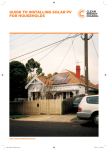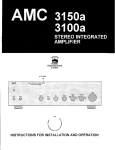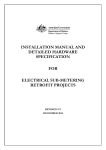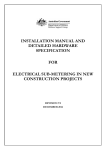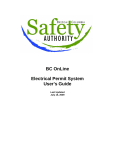Download Guide to installing solar PV for households
Transcript
GUIDE TO INSTALLING SOLAR FOR HOUSEHOLDS visit solaraccreditation.com.au CONTENTS WHY INVEST IN SOLAR? 2 CONNECT TO THE GRID THE INSTALLATION PROCESS 3 APPLICATION TO CONNECT 21 DO YOUR RESEARCH 4 METER CHANGE AND CONNECTING TO THE GRID 21 TYPES OF SOLAR PV SYSTEMS 5 MAINTAIN AND ENJOY YOUR SOLAR SYSTEM 22 SYSTEM MAINTENANCE 23 INSPECTIONS 23 UPGRADING YOUR SYSTEM 23 WHAT IF SOMETHING GOES WRONG? 24 WARRANTIES 24 COMPLAINTS 24 WORKMANSHIP COMPLAINTS 24 ELECTRICAL SAFETY 24 HOW MUCH DO SOLAR PV SYSTEMS COST? 6 SOLAR LEASING 6 GOVERNMENT INCENTIVES 7 SMALL-SCALE TECHNOLOGY CERTIFICATES (STCS) 7 HOW MUCH OF A DISCOUNT WILL I RECEIVE FROM THE STCS? 20 7 CONTACT YOUR ELECTRICITY RETAILER 8 QUESTIONS TO ASK YOUR ELECTRICITY RETAILER 9 FEED-IN TARIFFS 9 FIND A SOLAR RETAILER AND PLAN YOUR SYSTEM 12 WHO’S WHO IN THE SOLAR MARKET 13 ARE THEY REPUTABLE? 13 CHOOSE A CLEAN ENERGY COUNCIL APPROVED SOLAR RETAILER 13 DO THEY HAVE RELEVANT EXPERIENCE? 14 QUESTIONS TO ASK YOUR SOLAR PV RETAILER 14 IS YOUR INSTALLER CLEAN ENERGY COUNCIL ACCREDITED? 14 SYSTEM DESIGN 14 WHAT SIZE SOLAR PV SYSTEM SHOULD I INSTALL? 15 UNDERSTAND YOUR ENERGY CONSUMPTION 15 WHAT TYPE OF PV MODULES OR INVERTER SHOULD I BUY? 15 SIGN A CONTRACT 16 INSTALL YOUR SYSTEM 18 DOCUMENTATION 19 DID YOU BUY YOUR SYSTEM FROM A CLEAN ENERGY COUNCIL APPROVED SOLAR RETAILER? 24 WHAT SHOULD I DO IF THE COMPANY HAS GONE OUT OF BUSINESS? 24 GLOSSARY AND DEFINITIONS 25 Guide to installing solar for households 1 WHY INVEST IN SOLAR PANELS? With electricity prices on the rise and millions of Australians now living in homes with solar photovoltaic (PV) systems on their rooftops, there has never been a better time to consider going solar. But, with the varied range of products and retailers on the market, being an informed consumer and doing your research has also never been more important. This guide assists householders with their solar system purchasing decisions and provides an overview of the installation process. 2 Guide to installing solar for households Solar panels have been installed on the rooftops of houses and other buildings in Australia since the 1970s. As of September 2015, more than 1.4 million rooftop solar systems had been installed right across Australia, safely and reliably delivering clean electricity to homes and businesses. Before making the decision to install solar, it is important to consider whether the investment will be worthwhile for you. As the cost of solar has fallen, so have government incentives. A number of different factors affect payback periods and whether you should go solar. The most benefit is gained by ‘self-consumption’ – that is, offsetting the higher retail tariff that you would pay by using power generated by your system instead of drawing power from the grid. So, you should consider your household electricity consumption when choosing your system size. When choosing a solar PV retailer, it’s important to do your homework and shop around for the best deal. The Clean Energy Council recommends you choose an Approved Solar Retailer that has signed on to the Solar Retailer Code of Conduct. Approved Solar Retailers provide a five-year, whole-of-system warranty, are committed to providing a quality product and service, and only use Clean Energy Council-accredited installers. THE INSTALLATION PROCESS 1 DO YOUR RESEARCH 2 CONTACT YOUR ELECTRICITY RETAILER 3 FIND A SOLAR RETAILER AND PLAN YOUR SYSTEM 4 SIGN A CONTRACT 5 INSTALL YOUR SYSTEM 6 CONNECT TO THE GRID 7 MAINTAIN AND ENJOY YOUR SOLAR SYSTEM Guide to installing solar for households 3 DO YOUR RESEARCH BEFORE YOU DECIDE TO INVEST IN SOLAR, IT’S IMPORTANT TO DO YOUR RESEARCH SO YOU KNOW WHAT WILL WORK FOR YOU. THINK ABOUT WHAT TYPE OF SYSTEM YOU WANT TO INSTALL, HOW MUCH YOU WANT TO SPEND AND WHAT GOVERNMENT SUBSIDIES YOU MIGHT BE ELIGIBLE FOR. 1 4 Guide to installing solar for households TYPES OF SOLAR PV SYSTEMS A solar PV system is made up of a mounting frame with PV modules and an inverter that converts the power from DC (direct current) to AC (alternating current), so it can be used in your home or exported back to the grid. GRID-CONNECTED SOLAR PV SYSTEMS This is the most common form of solar system installed in Australia. The inverter converts the electricity generated by the solar system – which is direct current (DC) – into AC electricity so that the power generated is compatible with the grid. Most houses with grid-connect solar systems use solar power first before sourcing electricity from the grid. When the panels are not producing electricity at night, electricity is supplied from the electricity grid. GRID-CONNECT WITH BATTERY BACK-UP SOLAR PV SYSTEMS Grid-connect PV systems with battery back-up (sometimes referred to as uninterrupted power supply or hybrid solar PV systems) are becoming increasingly popular. With solar customers in many states now receiving a low price for electricity sold back to the grid, battery back-up systems can be a viable alternative as they use the electricity stored during the day to run your house at night. They also have the advantage of being able to supply power during power outages. STAND-ALONE SOLAR PV SYSTEMS Stand-alone systems are not connected to the electricity grid and typically are installed in remote areas where there is limited connection to the grid, or areas of low electricity demand. Unlike their grid-connected counterparts, these systems must have batteries or backup generation to provide supply at night. In many cases they will also include a diesel or petrol generator to supplement energy supply. PV electricity output (DC) Grid-connected solar PV systems Installers and designers need Clean Energy Council grid-connect accreditation Grid-connect with battery back-up solar PV systems Installers and designers need Clean Energy Council grid-connect accreditation with battery back-up endorsement, OR both grid-connect AND stand-alone accreditation Stand-alone solar PV systems Installers and designers need Clean Energy Council stand-alone accreditation Solar PV modules Supplying DC power 1 WHO CAN DESIGN AND INSTALL WHAT? 2 Inverter An inverter changing the solar DC power into 240V alternating (AC) suitable for your household appliances and feeding into the grid 3 Switchboard (electricity to house) Your home uses electricity firstly from the solar PV modules with additional demand supplied from the grid 5 4 Meter A meter measuring your electricity production and consumption Electricity network (grid) Any excess is exported back into the electricity network Guide to installing solar for households 5 HOW MUCH DO SOLAR PV SYSTEMS COST? THE PRICE OF YOUR SOLAR PV SYSTEM CAN BE AFFECTED BY A NUMBER OF FACTORS, INCLUDING: • • • • • • government incentives and support schemes contractor installation costs type and number of panels type and size of inverter type of framing equipment and other system components height and accessibility of roof and whether it is tiled or metal or concrete • any after sales service agreements Keeping these variables in mind, this table provides an approximate guide on the price range for grid-connected solar PV systems in the major capital cities. Government incentives are included in these figures. Note that the market costs change quickly and so these numbers are illustrative only. ESTIMATED GRID CONNECT SYSTEM PRICE SYSTEM SIZE ESTIMATED PRICE RANGE 1.5 kW $3000 - $6000 2 kW $3500 - $6500 3 kW $4500 - $7500 4 kW $5500 - $9500 5 kW $7000 - $11500 Please note: these prices are a guide only. The actual price you are offered for a solar PV system may vary. Figures are estimates based on market conditions as at 17 June 2015 (Solar Choice as cited in Climate Spectator). FINANCING MODELS FOR ROOFTOP SOLAR A few years ago there was only one way for Australian households to invest in rooftop solar – to buy and own the system upfront. This is still the most popular way to purchase solar in Australia, but new ways to finance rooftop solar systems have emerged in recent times. These allow you to install solar without having to pay the upfront costs in one lump sum. Solar leasing A solar lease could lower your electricity bill with no upfront cost, provided the savings on your electricity bill are greater than your repayments. Solar leasing is a very popular financial model in some overseas markets (especially the US), but is still quite new in Australia. Solar leases are just like leases for other household goods. A company will install and maintain the solar PV system, and the customer makes monthly payments. Some solar companies also offer leasing with a ‘performance guarantee’ that the system will produce a minimum amount of electricity. Although the return on investment may be less than purchasing a solar system upfront, there are advantages to solar leasing – like the maintenance being taken care of by the solar retailer, and no upfront costs. You can expect to pay more for stand-alone and grid-connect battery back-up systems with more in-depth design requirements and the added cost of batteries and equipment. Before you commit to a solar lease, ensure you are fully aware of the full charges associated with any contract, and any early exit penalties. Extra costs to be aware of that might not be included in your initial quote: Solar Power Purchase Agreements (PPAs) Like solar leasing, solar PPAs can also lower your electricity bill with no upfront cost. The difference is that solar leases require you to pay monthly, whereas payment for PPAs is made based on how much electricity you agree to buy. • • • • • 6 application to connect to the grid meter change or reconfiguration upgrades to your switchboard or cabling removal of trees or other shading site preparation needs (for example, condition of roof or ground) Guide to installing solar for households Solar PPAs are generally suited to customers with a large demand for electricity, and are most commonly taken up by businesses. Solar PPAs are not yet available in all states and territories. GOVERNMENT INCENTIVES SMALL-SCALE TECHNOLOGY CERTIFICATES (STCS) HOW MUCH OF A DISCOUNT WILL I RECEIVE FROM THE STCS? Government incentives in the form of Small-scale Technology Certificates (STCs) help reduce the upfront cost of installing your solar PV system. Australia is divided up into various zones based on how much renewable energy can be generated by a solar panel in a given area. STCs are an electronic form of currency and are allocated to you when you install a solar PV system. One STC is equivalent to one megawatt-hour of electricity generated by your solar PV system. The price of STCs changes according to market conditions. The total level of subsidy you receive will depend on a number of factors, including the location and size of the solar PV system and the price of STCs at the time the system was installed. The same size system installed in Melbourne or Hobart (zone 4) receives fewer STCs than those installed in sunny Sydney (zone 3) or Darwin (zone 2), where systems can produce more energy. There are two ways you can be paid for your STCs: The table below shows the level of financial support available from STCs on solar PV systems in the major capital cities of Australia. 1. Assign your STCs when you purchase your solar PV system to a registered agent in exchange for a financial benefit, which may be in the form of a delayed cash payment or upfront discount on your solar PV system (most consumers take this option, and your solar retailer will usually make the arrangements on your behalf), or 2. Create the STCs yourself by finding a buyer and then selling and transferring them in the Renewable Energy Certificate (REC) Registry. You can use the REC Registry calculator on the Clean Energy Regulator’s website to determine your approximate level of subsidy: rec-registry.gov.au ELECTRICITY RETAILER PAYMENTS Your electricity retailer might pay you for the electricity you export back to the grid. Rates vary between electricity retailers. In some states the government regulates a minimum rate and some state governments leave it to consumers to negotiate a deal with their electricity retailer. See ‘feed-in tariffs’ on page 9. For more information, contact the Clean Energy Regulator: www.cleanenergyregulator.gov.au/RET STC SUBSIDY CITY ZONE RATING SYSTEM SIZE DEEMING PERIOD TOTAL STC ENTITLEMENT TOTAL SUBSIDY ADELAIDE 3 1.382 3 kW x15 (years)= 62 $2170 (62 STCs x $35) BRISBANE 3 1.382 3 kW x15 (years)= 62 $2170 (62 STCs x $35) CANBERRA 3 1.382 3 kW x15 (years)= 62 $2170 (62 STCs x $35) DARWIN 2 1.536 3 kW x15 (years)= 69 $2415 (69 STCs x $35) HOBART 4 1.185 3 kW x15 (years)= 53 $1855 (53 STCs x $35) MELBOURNE 4 1.185 3 kW x15 (years)= 53 $1855 (53 STCs x $35) PERTH 3 1.382 3 kW x15 (years)= 62 $2170 (62 STCs x $35) SYDNEY 3 1.382 3 kW x15 (years)= 62 $2170 (62 STCs x $35) Zone rating x rated power output (3 kW) x deeming period (15 years) = total STC entitlement. Figures based on an STC rate of $35. This is an approximate rate and the STC price will vary. For more information, contact the Clean Energy Regulator. Guide to installing solar for households 7 CONTACT YOUR ELECTRICITY RETAILER BEFORE YOU AGREE TO HAVE A SOLAR PV SYSTEM INSTALLED, IT IS IMPORTANT YOU UNDERSTAND WHAT WILL HAPPEN TO YOUR ELECTRICITY TARIFF AND YOUR ELECTRICITY BILL IF YOU INSTALL SOLAR. CONTACT YOUR ELECTRICITY RETAILER TO FIND OUT ABOUT WHAT FEED-IN TARIFFS ARE AVAILABLE AND HOW SOLAR WILL AFFECT YOUR CURRENT ELECTRICITY TARIFF, AND CAREFULLY WEIGH UP THE ADVANTAGES AND DISADVANTAGES BEFORE MAKING A DECISION. 2 8 Guide to installing solar for households NOT ALL ELECTRICITY RETAILERS OFFER SOLARFRIENDLY POLICIES, SO IT IS BEST TO CHECK AND COMPARE THE FOLLOWING ITEMS BEFORE ENTERING INTO AN ELECTRICITY TRADING AGREEMENT. QUESTIONS TO ASK YOUR ELECTRICITY RETAILER: What price will they pay you for your electricity, in cents per kilowatt-hour (kWh)? What is the cost of the electricity you purchase from them (in cents per kWh) and will you lose your off-peak rates once you install solar? Will you be charged a higher daily fixed charge component if you connect solar? Are there any penalty clauses (termination costs) or other administration fees? What will be the form of payment for electricity you produce? For example will you receive cash or a credit on your electricity bill? FEED-IN TARIFFS A feed-in-tariff is the rate you are paid for electricity generated by your solar PV system that you export back to the grid. All feed-in tariffs on offer are now ‘net’ feed-in tariffs. This means that the electricity produced by your solar panels will be used in your home first, and then any extra electricity will be exported to the grid. The feed-in tariffs offered differ from state to state, and from retailer to retailer. In some states the government regulates a minimum rate, and in other states it is up to you to negotiate a deal with your electricity retailer. It is worth shopping around to find out which electricity retailers offer better rates for solar customers. Feed-in tariffs are usually only available for solar systems up to a maximum size. This maximum varies from 5 kW to 100 kW depending on where you live and your electricity retailer. Contact your electricity retailer or the relevant state government department for details. The table on the following page shows the feed-in tariffs introduced in the various states, and the savings that could be made on a 3 kW system based on the average household energy consumption of 17 kWh/day. These savings are an estimate only and your individual situation is likely to differ from these. A CEC-accredited designer will be able to calculate your potential savings as part of their load analysis. The actual savings you make may also vary depending on the electricity retailer you are with. You can also contact the relevant state government departments for more details on feed-in tariffs in your state. • ACT: Environment and Planning Directorate 13 22 81 • NSW: Department of Industry, 1300 136 888 • NT: Department of the Chief Minister, (08) 8999 5511 • QLD: Department of Energy and Water Supply, 13 43 87 • SA: Department of Water, Energy and Environment, 08 8204 1888 What are the billing/payment periods? • TAS: Department of Infrastructure, Energy and Resources, 1300 135 513 AFTER YOUR SYSTEM HAS BEEN INSTALLED, MAKE SURE YOUR ELECTRICITY BILL REFLECTS THE CORRECT TARIFF. • VIC: Energy and Earth Resources Division, 136 186 • WA: Public Utilities Office (08) 6551 1000 Guide to installing solar for households 9 FEED-IN TARIFFS SAVINGS STATE BY STATE 3 KW SYSTEM BASED ON THE AVERAGE HOUSEHOLD ENERGY CONSUMPTION OF 17 KWH/DAY. VIC SA QLD SOUTH EAST QLD SOUTH EAST QLD Scheme name Feed-in tariff Minimum Retailer Payment Negotiated Feed-in Tariff Negotiated Feed-in Tariff Ergon Mandated Tariff Scheme nature Mandatory Mandatory Voluntary Voluntary Voluntary 2015/16 rate c/kWh 6.2c 5.3c 12c 6c 6.5 Annual FIT value, 5% exports $12 $12 $28 $14 $15 Annual FIT and offset value $1056 $1336 $1349 $1335 $1336 Annual FIT value, 25% exports $61 $61 $138 $69 $75 Annual FIT and offset value $885 $1106 $1181 $1112 $1118 Annual FIT value, 50% exports $122 $122 $276 $138 $150 Annual FIT and offset value $671 $818 $971 $833 $846 Annual FIT value, 75% exports $183 $183 $414 $207 $225 Annual FIT and offset value $458 $531 $762 $555 $573 Current as at April 2015 Contact the relevant state government department for more details and up-to-date offers and rates *This applies to Horizon Power areas only. Rates can vary from 10c to 41c per kWh. Check with Horizon Power for details. 10 Guide to installing solar for households WA WA ACT NT TAS NSW NSW REBS* REBS Solar Buy Back Scheme Solar PV Buy Back Solar Buy Back Tariff Solar Feed-in Tariff Benchmark Solar Feed-in Tariff Benchmark Voluntary Voluntary Mandatory Mandatory Mandatory Voluntary Voluntary 41c 7.1c 7.5c 26.7c 6.1c 5.5c - $99 $17 $18 $64 $12 $12 - $1321 $1240 $855 $1286 $813 $954 $942 $494 $86 $88 $321 $58 $59 - $1459 $1051 $750 $1286 $691 $803 $744 $988 $172 $177 $643 $117 $117 - $1631 $815 $618 $1286 $539 $613 $496 $1482 $258 $265 $964 $175 $176 - $1803 $579 $485 $1286 $386 $424 $248 Guide to installing solar for households 11 FIND A SOLAR RETAILER AND PLAN YOUR SYSTEM IT’S IMPORTANT TO SHOP AROUND WHEN BUYING SOLAR. BEFORE YOU SELECT A SYSTEM, TALK TO DIFFERENT SOLAR PV RETAILERS ABOUT OPTIONS AND OBTAIN SEVERAL QUOTES. IF POSSIBLE, SPEAK WITH OTHER PEOPLE IN YOUR LOCAL AREA WHO HAVE INSTALLED SOLAR POWER SYSTEMS. YOU MAY BE ABLE TO PICK UP SOME TIPS FROM THEIR EXPERIENCES. 3 12 Guide to installing solar for households WHO’S WHO IN THE SOLAR PV MARKET The main parties involved in the sale and installation of solar PV are the solar retailer, designer and installer. Sometimes these roles are filled by one individual, which is typically the case with small retail businesses run by a qualified installer/ designer. However, two or three different entities can be involved with medium- to large-sized companies that subcontract out their designs and/or installations. Many solar PV retailers in the industry now sell systems directly to consumers and subcontract the installation of those systems. ARE THEY REPUTABLE? When selecting your solar retailer, make sure you go with a reputable company with proven experience. You should find out things like how long they have been in the solar industry, and whether they are an established company that will be around in the future if things go wrong. Warranties and workmanship guarantees cease if the company goes out of business. CHOOSE A CLEAN ENERGY COUNCIL APPROVED SOLAR RETAILER The Clean Energy Council Solar Retailer Code of Conduct helps consumers choose a retailer that has committed to offer a high level of quality and service. Selecting an Approved Solar Retailer is one way to make sure you will be dealing with a company that prides itself on being an industry leader. Contact the solar retailer/installer/ designer’s former customers to find out if they were knowledgeable, easy to work with, and took the time to explain the system’s operation. Also find out if their systems are working well, if there have been any problems, and, if so, if their installer returned to fix them. Approved Solar Retailers: Online and mail-order solar retailers that never visit your home or business may have difficulty recommending the most appropriate equipment. A comprehensive, on-site solar and load analysis and two-way interview can help ensure a thoughtfully-designed and well-planned installation. The Solar Retailer Code of Conduct has been authorised by the Australian Competition and Consumer Commission. SOLAR RETAILER ACCREDITED DESIGNER ACCREDITED INSTALLER an entity that sells solar equipment to customers a person who is accredited by the Clean Energy Council to design a solar PV system a person who is accredited by the Clean Energy Council to install solar PV systems • provide a 5-year whole of system warranty • use ethical sales practices • only use Clean Energy Councilaccredited installers • meet the very high standards of the Code of Conduct Companies that have signed on to the code can be identified by the ‘Approved Retailer’ logo (above). To see which companies have signed on to the code, visit approvedsolarretailer.com.au. Guide to installing solar for households 13 John Solar Accreditation ID card DO THEY HAVE RELEVANT EXPERIENCE? Try to establish how many systems similar to your system the designer/installer has completed, and when the designer/ installer last completed a system. Are they up-to-date on the newest products, the latest regulatory issues and connection requirements? Local companies or companies that operate within your state may have better experience in dealing with your distributor and be more familiar with any statespecific regulations. IS YOUR INSTALLER CLEAN ENERGY COUNCIL-ACCREDITED? To be eligible for government incentives, both the designer and installer of your solar PV system must be accredited by the Clean Energy Council. The Clean Energy Council’s accreditation scheme ensures that accredited designers and installers of solar PV power systems have undergone the necessary professional training, adhere to Australian Standards and follow industry best practice. For a list of accredited professionals, please see solaraccreditation.com.au/ consumers/find-an-installer Accreditation is given to the individual tradesperson who comes to your home to install your solar system, not the solar PV retailer. You may need to get back in contact with the company to check if the designer and installer they are using are accredited. An accredited installer can easily be identified by their use of the Clean Energy Council accreditation logo. Ask to see the installer’s accreditation ID card (above) when they show up at your home. 14 Solar PV retailers can choose to sign on to the Clean Energy Council Solar Retailer Code of Conduct. Signatories to the code have committed to provide a high level of quality and service, and offer a five-year, whole-of-system warranty. To find an Approved Solar Retailer visit approvedsolarretailer.com.au. SYSTEM DESIGN Your designer will tailor your solar PV system based on how much you want to spend or finance, how much electricity you wish to offset, and the physical properties of your premises. They will help you: • establish your electrical loads over an average day using a load analysis • determine the size of your solar PV system • choose the type of panels and inverter • establish the location of solar panels in relation to angles, available sunlight, shading and temperature As part of the design and feasibility, your designer/installer should give you an indication of what you can expect in terms of the performance of your system and the factors that may influence this. WATCH OUT FOR: • aggressive sales tactics • one-size-fits-all system designs • over-exaggerated claims of payback periods and system performance • large inverters with small systems* • pressure to sign on the spot. Remember, for unsolicited sales, you are entitled to a cooling-off period of 10 business days during which you may cancel the contract without penalty *Your ability to upgrade your system in future may depend on receiving permission from your distributor, on suitable PV panels still being available, and on any upgrades meeting current Australian Standards. Guide to installing solar for households QUESTIONS TO ASK YOUR SOLAR RETAILER: Are they a Clean Energy Council Approved Solar Retailer? Will they be available to troubleshoot and fix problems? If something goes wrong, who is responsible for repair or replacement costs? What performance guarantees do you get for the system as a whole, and can you get that information in writing? Do they provide some kind of optional service agreement? Who organises all the necessary metering changes and what are the associated costs? If problems arise with your system, what services will they provide and for how long? What workmanship and product guarantees do they offer? • Who is responsible for the warranties? • What happens to the warranties if they go out of business? • How long has the product manufacturer or importer been in the PV industry? • If you have to deal with the panel or inverter manufacturer or importer in the future, do they have an Australian office? WHAT SIZE SOLAR PV SYSTEM SHOULD I INSTALL? The size of your solar PV system will depend on: • what portion of your electrical consumption you wish to generate • the physical unshaded area available for the installation of your panels • how much you are prepared to spend UNDERSTAND YOUR ENERGY CONSUMPTION This is the first step to take when determining if solar is a viable investment. This process should be completed by your accredited designer during the design and specification stage as part of their load analysis. As a home owner, you can sell your excess electricity generated back to the grid. You do, however, need to consider the financial incentive to do so. In some states, there is currently little financial incentive to export energy to the grid. The most benefit is gained by ‘self-consumption’, which means offsetting the higher retail tariff that you would pay by using power generated by your system instead of drawing power from the grid. Accordingly, you should match your system size to your household consumption. The designer of your system will help you choose a system that suits your needs. The rate for any power exported will depend on your electricity retailer and which state or territory you are in. See ‘feed-in-tariffs’ on page 9. WHAT TYPE OF PV MODULES OR INVERTER SHOULD I BUY? When comparing quotes, the difference in prices between products can be overwhelming. When making the decision that best suits your budget, there are a few important things to consider: • What are the product warranties? Your solar retailer will provide a manufacturer’s warranty on the products. The warranty period will often vary between the panels, inverter and other system components. Clean Energy Council Approved Retailers have committed to provide a five-year wholeof-system warranty. • Will the solar retailer be able to honour these warranties? If the solar PV retailer goes out of business, your warranties could become invalid. In this case, you will need to contact the importer or manufacturer directly to arrange repair or replacement. Make sure you have their details too. • Does the manufacturer have a service office in Australia? Manufacturers that have support offices in Australia, or dedicated importers/registered agents of the products may offer better backup support if a component fails. • Are the PV modules and inverter Clean Energy Council-approved? All PV modules and inverters must meet Australian Standards and be on the Clean Energy Council-approved list in order to be eligible for any government rebates. • Are the PV modules imported through an approved channel? Be wary of PV modules that may not have been imported through channels approved by the PV module manufacturer. The manufacturer may not honour the warranty in this case. Check with your retailer who the importer was and whether they are approved by the manufacturer. Further information is available under ‘warranties’ on page 24. PV MODULE AND INVERTER STANDARDS Solar panels and inverters on the Clean Energy Council approved list meet all relevant Australian Standards. This is a minimum requirement. A range of independent PV module rating systems exist that set quality and performance standards above the minimum. These can provide more information when you are choosing which modules to buy. For more details on these independent tests, visit the Solar Accreditation website: http://www.solaraccreditation.com.au/installers/compliance-and-standards/standards/ pv-module-standards.html Guide to installing solar for households 15 SIGN A CONTRACT 4 16 Guide to installing solar for households AFTER YOU ACCEPT A QUOTE, YOUR SOLAR PV RETAILER, DESIGNER AND/OR INSTALLER WILL PROVIDE A CONTRACT FOR YOU TO SIGN. BEFORE SIGNING YOUR CONTRACT, HAVE YOU: Contacted your electricity retailer and asked about any tariff changes that may apply after solar is installed? Asked your solar PV retailer the questions on page 14? Compared quotes? Made an application to connect to network, as noted in ‘connecting to the grid’ on page 21? Ensured your solar PV retailer has detailed what the warranties are? The quote will often form the basis for your contract. Remember that once you have received the quote, you do not necessarily have to go ahead with installing a system. It is important that you are aware of the system design and performance estimates for the system before signing the contract. Once you have signed the contract, any variations to the system design must be documented and signed off by you before installation. If it is an unsolicited sale, you are entitled to a 10-day cooling-off period after signing a contract. ON TOP OF STANDARD CONTRACT CONDITIONS, YOU SHOULD ENSURE THAT THE FOLLOWING ARE INCLUDED: • clear itemisation of the component costs and whether the total price includes STCs • a site-specific full system design including the proposed roof plan • system performance estimates (daily, monthly and annual) • the expected efficiency losses due to shading or orientation • full disclosure of all assumptions made in relation to systems and finance offerings • the responsibility of each party for all aspects of the process (e.g. metering changes, grid connection, retail agreements, other paperwork) • warranties and guarantees, including installer workmanship • if signing a solar lease or PPA, you should request clear and accurate information about the conditions of finance. This includes: - the name of the lender to whom the consumer will be contracted - comparative cost of the same product purchased outright on that day - clear statement of fees and charges, including dollar values, whether the rates are fixed, and details of any exit penalties - clear statement on whether the consumer owns the system at the conclusion of the plan/agreement - who to contact with questions or complaints about finance terms • schedule of deposit and progress payments • service agreement • an agreed timeframe for installation • any site conditions or circumstances which may result in extra chargeable work required that is not covered in the initial contract Guide to installing solar for households 17 INSTALL YOUR SYSTEM 5 18 Guide to installing solar for households ONCE YOU’VE SELECTED A RETAILER, PLANNED YOUR SYSTEM AND SIGNED A CONTRACT, IT’S TIME FOR THE SYSTEM TO BE INSTALLED. Your solar PV retailer or installer should let you know when your system will be installed and provide you with all the necessary documentation on the day. YOU SHOULD RECEIVE: DOCUMENTATION • a basic connection diagram that includes the electrical ratings of the PV array and the ratings of all overcurrent devices and switches as installed Make sure you receive everything you need when your system is installed. Documentation will be essential if you need to make warranty or insurance claims. A system user manual should be provided by the installer on the day of installation. It is the responsibility of your solar retailer or installer to ensure that you have been provided with the system documentation. • a list of equipment supplied • the shutdown and isolation procedure for emergency and maintenance • system performance estimate • recommended maintenance for the system • maintenance procedure and timetable • the commissioning sheet and installation checklist • PV array frame engineering certificate for wind and mechanical loading • installer/designer’s declaration of compliance • warranty information • equipment manufacturer’s documentation and handbooks for all equipment supplied • a list of actions to be taken in the event of an earth fault alarm Guide to installing solar for households 19 CONNECT TO THE GRID 6 20 Guide to installing solar for households CONNECTING YOUR SOLAR PV SYSTEM TO THE GRID IS A TWO-STEP PROCESS THAT INVOLVES: 1. making an application to connect your system prior to installation (where required), and 2. a meter change/reconfiguration and connection to the grid. Your solar retailer will usually arrange connection of your solar system to the network on your behalf, including preparing and submitting all relevant documentation required from the electricity retailer and/or distributor for meter installation and connection to the network. It is important however to be aware of the process involved, who to contact to follow up on progress, and to ensure that all parties are acting in a timely manner. The grid connection process differs from state to state. Our grid connection guides provide a step-by-step process for your state and are available here: solaraccreditation.com.au/consumers/ small-scale-generation-connection APPLICATION TO CONNECT Most distribution companies require pre-approval to connect to their network. This should be done prior to sale and installation. Depending on the size of your system and the characteristics of the local grid you are connecting to, the technical requirements of your distributor may vary. Make sure your solar retailer or installer lodges this application early on in the process as the approval process can take up to eight weeks in some areas. METER CHANGE AND CONNECTING TO THE GRID Your existing meter will either need to be reconfigured or replaced by a new import/ export meter before you can connect to the grid. This may need to occur before or after installation, depending on the requirements in your state. Your solar retailer will need to notify either your distributor or electricity retailer to organise a meter change/reconfiguration. Meter change/reconfiguration is then carried out by your distribution company. You will be charged by your distribution company for any costs associated with the meter change. This can be charged to you by your solar retailer or billed to you through your electricity retailer. Make sure you are aware of these costs and how they will be charged. AFTER YOUR SYSTEM HAS BEEN INSTALLED CHECK: that you have you received all the necessary documentation from your installer that your meter has been changed or reconfigured (where required) that the correct tariff has been applied to your electricity bill by your electricity retailer Guide to installing solar for households 21 MAINTAIN AND ENJOY YOUR SOLAR SYSTEM 7 22 Guide to installing solar for households ONCE YOUR SOLAR SYSTEM HAS BEEN INSTALLED, IT’S TIME TO START SAVING MONEY ON YOUR ELECTRICITY BILLS – BUT YOU ALSO NEED TO MAKE SURE YOUR SYSTEM IS MAINTAINED SO IT CAN CONTINUE TO OPERATE EFFICIENTLY AND SAFELY. SYSTEM MAINTENANCE INSPECTIONS SOLAR PANEL RECYCLING A solar system is a complex electricitygenerating piece of equipment, and to keep it safe and operating efficiently, it is vital to both maintain your system and operate it safely. A maintenance schedule will be provided by your solar PV retailer or installer that you must take note of and follow. This is necessary to ensure that: Following the installation of your solar PV system, safety inspections may be carried out by the relevant electrical authority. Depending on which state you live in, these inspections may be mandatory or may occur on a random audit basis. In some states, your installer is responsible for organising the inspection of your system. The inspection may need to be carried out before the system can be connected to the grid. When your solar panels eventually reach the end of their life, panel recycling programs are being set up to ensure the materials are disposed of correctly or repurposed. • it is operating correctly • the system performance is maintained • the system is safe for everyone in the premises as well as for any electrical workers working on the distribution network Make sure you engage a CEC-accredited installer to undertake maintenance work on your solar PV system. Maintaining your system means much more than just cleaning your panels. An accredited installer will check that the system is functioning safely and efficiently, allowing you to maximise the savings on your power bills for years to come. Some distributors may request that an anti-islanding test of the inverter be carried out periodically. Check with your distributor as each will have different requirements. UPGRADING YOUR SYSTEM Your ability to upgrade your system in future may depend on receiving permission from your distributor, on suitable PV modules still being available, and on any upgrades meeting current Australian Standards. Upgrading your system may also result in losing your feed-in tariff. You will need to check with your electricity retailer and distributor to find out what the requirements are for upgrading your system. The requirements may differ from state to state. ‘Reclaim PV’ is one organisation that has set up a take back and reclaiming scheme. Reclaim PV has set up recycling partnership programs with several solar panel suppliers. When purchasing your solar panels, ask your supplier whether they have a panel recycling program in place. Visit reclaimpv.com for more information. Guide to installing solar for households 23 WHAT IF SOMETHING GOES WRONG? WARRANTIES WORKMANSHIP COMPLAINTS If you have an issue with any solar product while it’s under warranty, you should first contact your solar PV retailer in order to have the product replaced or repaired. If you are unable to contact your retailer, contact the importer or manufacturer. Contact details should be provided on the warranty documentation. If this is unsuccessful, you can lodge a complaint with the relevant Fair Trading or Consumer Affairs office in your state or territory (details listed below). They can negotiate on your behalf and arrange mediation where necessary. The Clean Energy Council aims to resolve complaints involving workmanship issues that breach the Accreditation Guidelines or relevant Australian Standards by a Clean Energy Council accredited installer. This does not extend to solar retailers (sales companies), it only applies to individual tradespeople who hold Clean Energy Council accreditation. Complaints can be registered online at solaraccreditation. com.au/consumers/solar-pv-warrantiescomplaints-and-disputes COMPLAINTS If you have a complaint of a commercial matter, including warranties, payments and contractual issues, then you should contact the relevant Fair Trading or Consumer Affairs office in your state or territory. • ACT: Office of Regulatory Services, (02) 6207 3000 • NSW: Fair Trading, 13 32 20 • NT: Consumer Affairs, 1800 019 319 • Qld: Office of Fair Trading, 13 74 68 • SA: Consumer and Business Services, 13 18 82 • Tas: Consumer Affairs and Fair Trading, 1300 654 499 • Vic: Consumer Affairs, 1300 558 181 • WA: Consumer Protection: 1300 304 054 24 ELECTRICAL SAFETY If you have a concern about the safety and technical compliance of your solar PV system, you can contact the electrical authority in your state or territory. • ACT: Planning and Land Authority, (02) 6207 1923 • NSW: Fair Trading, 13 32 20 • NT: NT WorkSafe, 1800 019 115 • Qld: Electrical Safety Office, (07) 3225 2000 • SA: Office of the Technical Regulator, (08) 8226 5518 • Tas: Office of Electricity Standards and Safety, (03) 6233 7851 • Vic: Energy Safe Victoria, (03) 9203 9700 • WA: EnergySafety, (08) 9422 5200 Guide to installing solar for households DID YOU BUY YOUR SYSTEM FROM A CLEAN ENERGY COUNCIL APPROVED SOLAR RETAILER? If you need to make a complaint against a company identifying itself as a Clean Energy Council Approved Retailer, you should first contact the company directly. If you are not satisfied with the response from the company, you should contact your relevant consumer protection organisation. You can also register your complaint with the Clean Energy Council, which will investigate breaches of the code. This may result in the retailer having its approval revoked. For more information on dealing with complaints about Clean Energy Council Approved Retailers, please visit approvedsolarretailer.com.au WHAT SHOULD I DO IF THE COMPANY HAS GONE OUT OF BUSINESS? If the solar retailer has become insolvent and you are unable to contact the manufacturer, you can lodge a complaint with the solar retailer’s administrators. You can find out if a company has become insolvent via the Australian Securities and Investments Commission (ASIC) website or by phoning 1300 300 630. Your local Fair Trading or Consumer Affairs office may also have information about the appointment of external administrators for insolvent companies. Likewise, if the manufacturer has gone into administration, you can lodge a complaint with the company’s administrators. As a consumer, you may become an unsecured creditor. If the external administrator fails to deal with your queries or complaints, you can also lodge a complaint with ASIC on 1300 300 630. GLOSSARY AND DEFINITIONS AUSTRALIAN CONSUMER LAW Australian Consumer Law provides consumers with certain automatic rights (called consumer guarantees) when they purchase a product or service. These consumer guarantees have no specific time limit, cannot be excluded, and exist regardless of any additional voluntary warranty provided by the solar retailer or manufacturer. It is important to remember that you have these rights as a consumer if the system does not meet reasonable expectations. Installation companies and/or manufacturers may choose to offer additional voluntary warranties which are over and above what they must automatically provide under Australian Consumer Law. For more details visit consumerlaw.gov.au THE DEFINITIONS FOR TERMS USED IN THIS DOCUMENT ARE AS FOLLOWS: • Accredited Designer – a person who is accredited by the Clean Energy Council to design a solar PV system • Accredited Installer – a person who is accredited by the Clean Energy Council to install solar PV systems • Approved Solar Retailer – a solar retailer that has signed on to the Clean Energy Council Solar Retailer Code of Conduct • Distribution Company – an operator of an electricity distribution system (poles and wires). Sometimes called a distribution network service provider (DNSP) • Distributor – see distribution company • Electricity retailer – an entity that delivers and sells electricity directly to the customer • Importer – an entity that imports solar equipment from overseas. May also be referred to as the ‘registered agent’ • Inverter – changes the solar DC (direct current) power into (alternating current) power suitable for your household appliances and to be fed back to the grid • kWh – kilowatt hour. A standard unit of electrical energy • PV – photovoltaic. Direct conversion of light into electricity • PV Array – an interconnected system of PV modules • PV Module – (also PV panel or solar panel) uses sunlight to generate DC power • Solar retailer or – retail businesses that are selling solar PV systems. This includes companies that sell systems to residential and small business consumers, and those selling to medium- and large-scale business consumers • System – the solar PV system. Refers to the entire arrangement, including PV modules and all other equipment required to make it work including inverters and components The information provided in this guide was accurate at the time of publishing (September 2015). For more up-todate information, check with the relevant government or regulatory body or speak to an Approved Solar Retailer. Guide to installing solar for households 25 SOLAR PV CHECKLIST Have you performed due diligence checks on your suppliers? • Is your solar retailer reputable - have you checked their track record, backers and complaints forums? • Is your system designer accredited by the Clean Energy Council to design the type of system you’re installing? • Does your installer have Clean Energy Council Accreditation for your system, and hold current electrical licences and OH&S certification? • Is the company a member of the industry association? • Is your solar retailer a signatory to the Solar Retailer Code of Conduct? • Have you checked ASIC to ensure they are legitimate and currently registered? • How long have they been in the solar industry? • How many systems similar to yours has the designer and installer completed? • Are they up-to-date on the newest products, the latest regulatory issues and connection requirements? • How well does the designer and installer know your local distribution network service provider (DNSP)? • Will they conduct the work themselves or subcontract parts out? If so, what contractual agreements are in place to protect you? The quotation and contract • Is it professional and sufficiently detailed? • Are the prices typical of industry benchmarks? • What is explicitly included and excluded? • If comparing quotations, am I comparing like for like? • Are all obligations, responsibilities and liabilities clear? • If you’re signing a solar lease or PPA, are all the fees, charges and exit fees detailed clearly? The financial calculations • Have they provided a detailed analysis of load and generation? • Are the returns consistent with Clean Energy Council guidelines? • What if any performance guarantees are provided? • Have you considered alternative methods of finance? The products and services • Have you been offered quality products that are well backed in case of warranty support? • Have you reviewed the warranty terms and conditions? • What written service obligations have been included? • Have you been offered workmanship guarantees? • Has system monitoring been included to allow ongoing performance checks and who is responsible? • Are the products listed by the Clean Energy Council as approved for use in Australia? • Do you understand the limitations to support and service that are offered? The grid connection and approvals • Has your DNSP been contacted and approved connection? Are there connection costs and limitations? • Has your retailer been contacted and agreed in writing any tariff impacts and/or export tariffs? • Do you require building approvals and if so have they been sought and approved? • Have metering and connection costs been calculated and agreed? Information and support • Have you received a detailed final contract including all relevant approvals? • Do you understand exactly what products, services, support and maintenance you are getting and from whom? • Have you been advised who or where to go to if you are unsatisfied? • Have you received training on system operation and a detailed operations manual? • Is the system performing as expected? CLEANENERGYCOUNCIL.ORG.AU




























